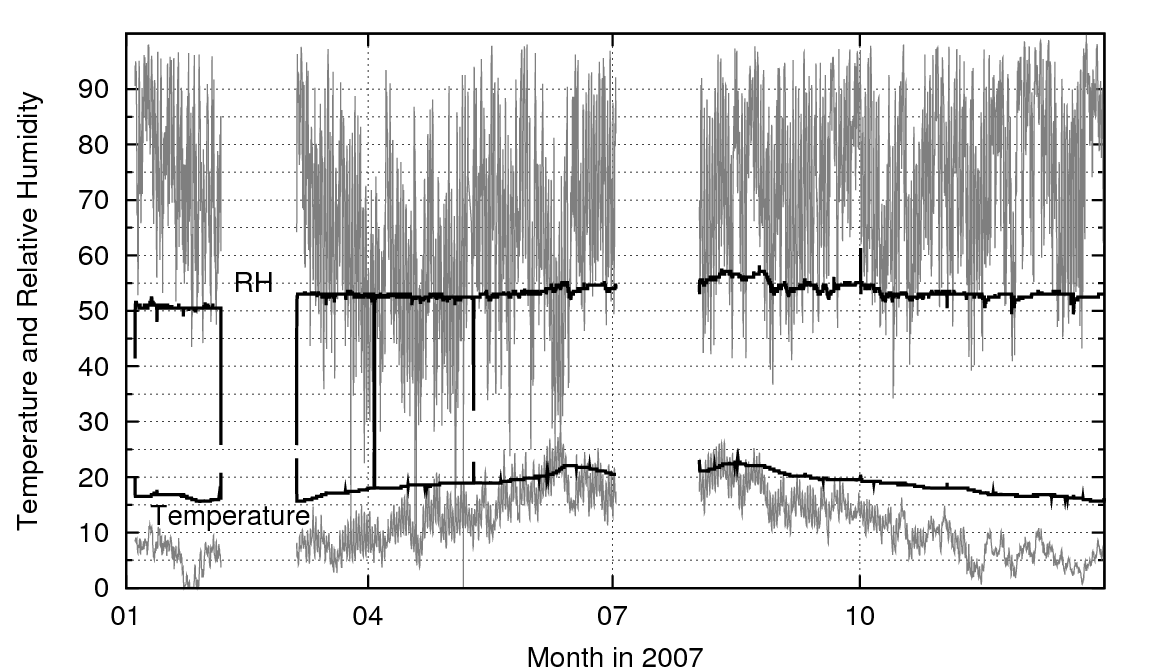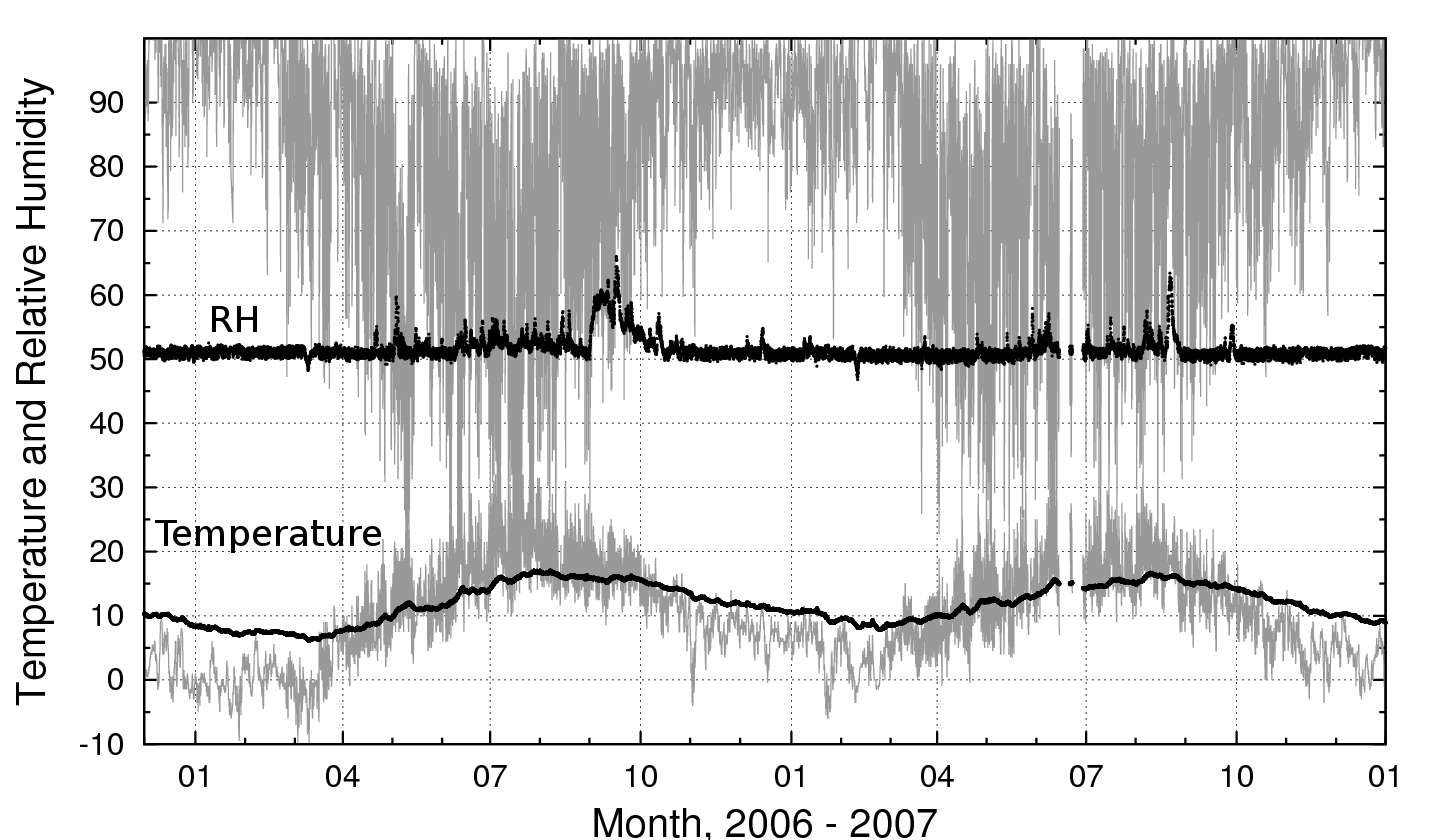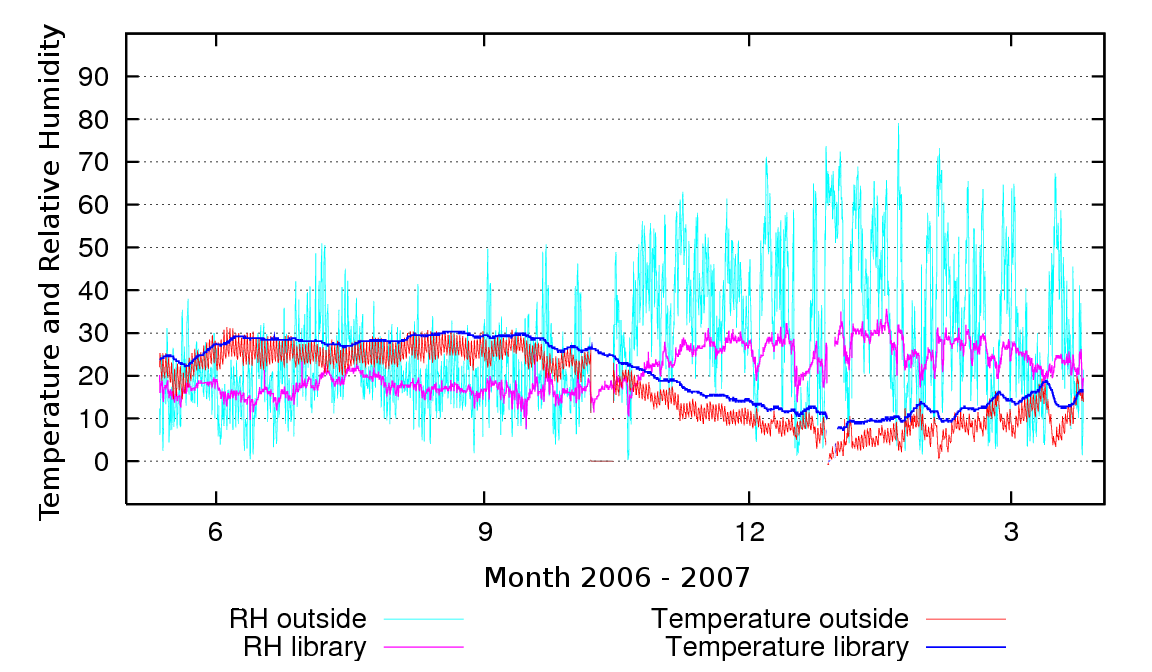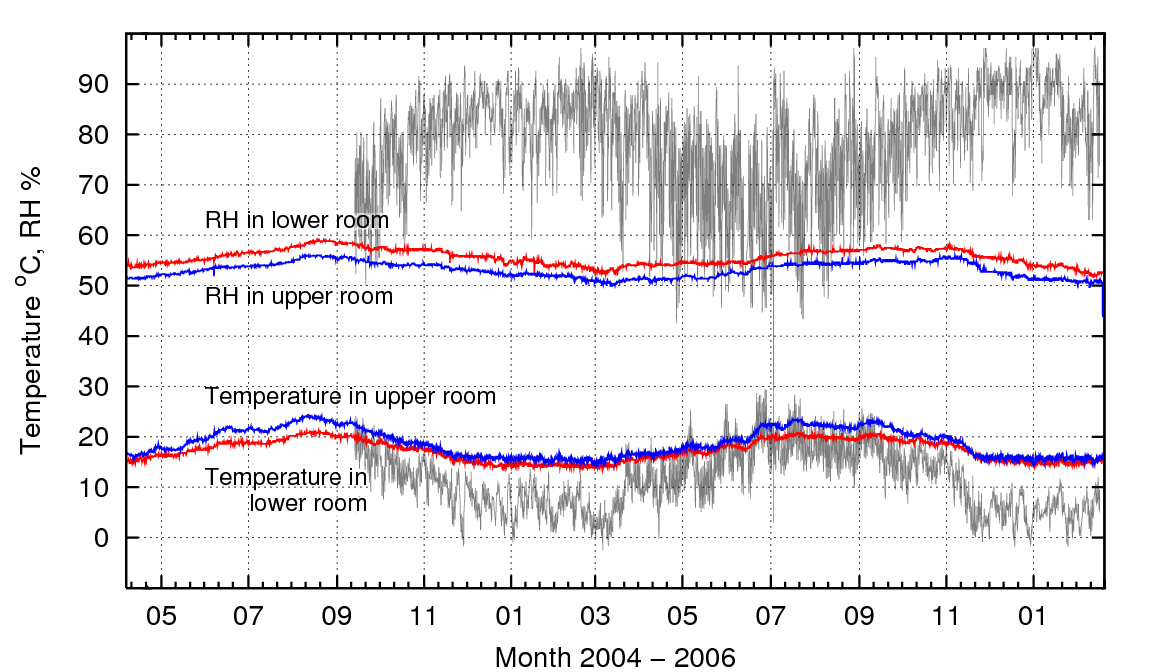
 |
Simple climate control in archives is hindered by too strict standards |
Author's note (January 2014): This published article has been made obsolete in detail by the publication in 2012 of the successor to BS5454:2000, which is PD5454:2012. However, it is still true that PD5454 forces air conditioning if its advice is used as a specification.
Tim
Padfield
tim@padfield.dk
KEYWORDS: archive, BS5454:2000, humidity, temperature, buffer.
SUMMARY:
There is now abundant built evidence that
archives can sustain a moderate relative humidity and temperature by
warming, or by dehumidifying. Four examples of museum storage
buildings, of diverse purpose, size and location, show adequate
climatic stability without air conditioning. However, it is not
possible without air conditioning to conform with the strict
temperature limits recommended in the widely used British Standard
BS5454:2000, which, though an advisory standard, is often used as a
building specification. The strictness of this standard is not
supported by evidence for chemical or physical damage if its limits
are exceeded, yet deference to it hinders the building of low energy
archives which are tolerant of loss of power and neglect.
1. Introduction
There are many specialised buildings that require a degree of climate control that is not considered necessary in ordinary houses, or even in offices and factories. Museums and archives in particular are expected to have a constant climate, in both temperature and relative humidity, and to have pure air.
One might think that the environmental requirements for these exotic buildings, always a tiny proportion of the total stock, are only of interest to a few specialists. However, one can argue that a detailed study of these buildings provides valuable lessons for the construction of buildings for other purposes. In particular, this study illustrates the arbitrary limitations to energy efficiency set by standards of doubtful quality, and the physical limitations set by current building technology.
2. The tyranny of the standard
A serious constraint encountered by the designer of an archive or museum is the specified indoor climate. I take as an example the British standard for archives BS5454:2000 [British Standard 2000]. This is an influential document. Obeying it is obligatory for British archives [National Archives 2004]. It has also been invoked in projects outside the UK, for example the storage building of the Royal Library in Copenhagen. It is also common for standards developed in temperate climates to be considered applicable in exotic climates, such as the Egyptian desert (St. Catherine's Monastery library, Sinai). The widespread use of the British standard is because the international standard, ISO 11799:2003, is not prescriptive, giving only general guidance which cannot be used as a specification because it contains no exact numbers. It is the didactic nature of the British standard which has made it so influential. But is it right?
Unlike scientific articles, the standard is anonymous - its authors shelter behind the prestigious names of the participating organisations. Yet it claims to be based on scientific principles and findings. In its favour, the standard does not assert that the climate must be as it advises, but in practice the standard is used as a specification, with legal force. The standard recommendation is unattainable without air conditioning. I illustrate this assertion later, but first I describe the recommended climate and try to understand why it is so tightly constrained.
"The temperature set point must be between 16°C and 19°C with a tolerance of 1°C on either side, but ranging neither below the minimum nor above the maximum."
This is tricky to achieve in any building, anywhere, even with air conditioning.
"Relative humidity should be at a fixed point between 45% and 60% with a tolerance of 5% on either side, but ranging neither below the minimum nor above the maximum."
Amazingly, this is easy to achieve in an archive, provided it is full of paper and cardboard boxes which buffer the relative humidity, and provided the air exchange rate is low. Demonstrating a constant relative humidity in an empty archive room, which is necessary to persuade the client to take over the building, is another matter, considered in a later section.
The standard furthermore demands that "The air within the repository should not be stagnant". That forces the use of fans and consequently activates another demand: "If a mechanical ventilation system is provided it should be designed to reduce pollutant concentration by introducing a proportion of fresh air".
Given that the temperature and RH are already so strictly defined, air movement surely has no significance. Air movement itself has no reported effect on biological growth but it is customarily invoked as an indirect defence against fungal growth. Moving air serves to transport heat to cold surfaces, typically in corners of outside walls, where local low winter temperature results in a raised local RH. If the RH is as specified throughout the building, there is no need to avoid stagnant air. Indeed many archived papers are kept in boxes, thus ensuring stagnant air. A method of achieving the specified climate is elevated by the standard to an independent requirement.
The argument for introducing a portion of fresh air is unconvincing. Clean air is a rare commodity, unknown in cities, where most archives are built, so pollutants are pumped into the archive. Pollution generated within the archive through outgassing from the furniture, and from the archived material, is a well known threat in museums. Morten Ryhl-Svendsen [Ryhl-Svendsen 2007a, 2007b] has shown that at least two air changes per hour is necessary materially to reduce the threat from internally generated pollutants, while it is possible to attain the same purity by recirculating the air through a carbon filter, without importing pollutants generated outside. Two exchanges with outside air per hour will destroy the humidity buffering performance, which only works effectively at less than one air change every ten hours.
The strict limits for temperature are designed to minimise the risk of condensation when papers are brought from the archive to a reading room at a congenial temperature for people. According to the standard, the narrow temperature range is "In order to avoid the need for acclimatization when documents move from storage to reading room and back,..."
The upper temperature limit is still below the temperature of most reading rooms, so one need only consider the worst case, the archive lower limit at 16°C with a reading room in summer at 22°C and 60% RH. The RH in the layer of air immediately adjacent to the cool object will rise momentarily to 87%, which would cause a considerable migration of water from air to object, and then back again as the object re-equilibrates to the room climate. In reality, the first molecules absorbed into the paper will release heat of condensation. So the paper will warm up quickly and the theoretical water content in equilibrium with 87% RH will never be reached.
The standard allows seldom used items to be stored at a fixed point between 16°C and 13°C, with the same one degree tolerance. One wonders how the standard committee decided on this lower limit, and its containment within a two degree window.
3. The damage caused by the environment
Archives contain materials of different durability. Only paper, parchment and cellulose acetate film have been studied thoroughly. Paper and parchment are so durable compared to the human life span that accelerated ageing has to be employed in scientific studies. Extrapolation according to the activation energy concept is then applied to predict durability at low temperature, from degradation rates typically measured at 60 - 100°C. There are many published studies, one of the latest is by [Balažic 2007]. Rag paper is notably more durable than paper made from ground wood pulp, so only relative deterioration rates are quoted for the archives which are described in this article. The deterioration rate is based on a fictitious, but typical, hydrolysis reaction with an activation energy of 100KJ/mol. The calculation is described in [Padfield 2004].
There is no evidence which suggests a low temperature limit for safe storage. Calhoun [Calhoun 1952] found no damage to photographic film from cold storage. Colour film and acetate base film is now stored at low temperature, down to -20°C, in many archives. Mecklenburg and co-workers [Mecklenburg 2005] show that some materials become brittle at low temperature but that does not necessarily damage their durability if they are not disturbed.
The safety of low temperature exposure is attested by the practice of some museums to put objects returning from exhibition through a sudden exposure to -30°C for one day, to kill bugs that may be hitching a ride into the store. The National Museum of Denmark has reported one object damaged, among tens of thousands that have been subjected to this extreme temperature. [Jensen 2008].
It is conceivable that variation in temperature can cause deterioration additional to that caused by the steady temperature advocated by the standard. Bigourdan and Reilly [Bigourdan 2002] assert that the damage done to paper by daily temperature cycling between 60°C and 80°C was indistinguishable from that which would be caused by steady exposure to the two temperatures in sequence. Henry Wilhelm [Wilhelm 1993] quotes Kodak sources stating that repeated cycling of film between cold store and ambient does no damage. On the other hand Bogaard,and Whitmore [Bogaard 2002] have shown that RH cycling between 25% and 75% every two hours, at constant temperature, does damage paper, through mechanical disruption of the polymer molecules . However, constant RH is easy to achieve in a passively controlled archive.
The condensation danger inherent in transferring materials between cold storage and reading room is discussed by Padfield [Padfield 2002] who shows that slow temperature change is safe, provided the temperature gradient does not exceed 7°C within the object and its immediate enclosure. The relative humidity within a close fitting enclosure will remain nearly constant, unaided.
This brief survey of the evidence for temperature effects on artifacts suggests that the two degree window allowed by the standard is based on the principle that the best achievable constancy cannot be bad, rather than on quantitative evidence that it provides significant benefit. The consequent expense and complexity remain a problem for the building operator. A gentle annual cycle in temperature is not allowed. The possibility of increasing the lifespan of materials by storage below 13°C is not allowed. The standard provides no evidence to back its stringency and its logic is faulty in several paragraphs, particularly those concerning the need for ventilation.
4. Archives without air conditioning
There are several archives and museum stores which do not use air conditioning and which deviate, often surprisingly little, from the BS5454 prescription. In the temperate zone there are two basic ways of controlling the climate in a museum store. The store can be heated to maintain about 50% RH, which means that it should hover about 7°C above the ambient temperature. Selective pumping of outside air can reduce the average temperature excess and humidity buffering can remove the need for excess temperature in summer. Alternatively the store can be dehumidified to 50% RH, while its temperature is allowed to follow the running average outdoor temperature. In favoured climates, it may not be necessary to heat or to dehumidify. I describe one example of each of these alternatives.
An example of an archive heated to maintain approximately 50% RH is the Arnemagnaean archive at Copenhagen University. The heat leaks in from the continuously heated office area, at a rate corresponding to about 5kWh per cubic metre per year. Heat leaks out through two thinly insulated outer walls, so that the temperature of the archive hovers midway between the constant 22°C of the building interior and the outside temperature with an annual cycle from about zero to 19°C. The too low temperature in summer is compensated by the humidity buffering, aided by selective pumping of outside air. The building is shown in figure 1 and the interior and exterior climate is shown in figure 2. The RH varies between 50% and 57%, within the BS limits, but the temperature cycles from 16°C in winter to 22°C in summer. The relative deterioration rate is 1.46, compared with the minimum BS5454 rate (17°C at 50% RH) taken to be unity.

FIG. 1: The archive of the Arnemagnaean Institute of Copenhagen University is concealed behind the windowless area of the building (left). The archive, sectioned in the right hand picture, is insulated against both the internal and the outdoor temperature, so that its temperature is always about half way between the constant 22°C of the building and the variable outdoor temperature.

FIG. 2: The climate in the Arnemagnaean archive during 2007 (bold traces), compared with the outdoor climate (the jagged grey traces). [Jakobsen 2008]
An example of a dehumidified museum store is the Vejle storage building, described in detail by [Rasmussen 2007]. The interior climate is shown in figure 3. The temperature is a heavily buffered annual cycle from 8°C to 18°C, probably mainly moderated by the uninsulated concrete floor. The annual energy use is 2kWh per cubic metre, entirely spent on dehumidification. The relative deterioration rate is 0.67. The temperature cycle, however, wanders far outside the BS limits.

FIG. 3: Temperature and relative humidity outside (jagged grey) and within (bold lines) the Vejle storage building.
Finally, a very economical library is in St Catherine's Monastery, high in the mountains of Sinai, Egypt. Its climate is shown in figure 4. The energy consumption is zero and the relative deterioration rate is, astonishingly, 0.97. The temperature cycle is from 8°C to 30°C, but the low relative humidity compensates for the high summer temperature. Low RH, particularly the 15% reached in summer, worries conservators, but the library contains some of the oldest paper and parchment in existence, reaching back to the fourth century AD. The present library building dates from 1947 but the books must have been stored in a similar, natural climate during the 1500 years of the library's existence.

FIG. 4: The climate in the library of St Catherine's Monastery, Sinai, Egypt. [Justin 2007]
For comparison, the annual energy consumption of the recently built store of the Royal Library in Copenhagen is 30kWh per cubic metre [Bruun 2007]. Its relative deterioration rate is unity, because it conforms to BS5454.
One has to question whether air conditioning to BS5454, with the associated expense of constant surveillance by skilled engineers, is justified by greater durability of the stored items. Unstable materials such as film are already stored in cool rooms, beyond the scope of this article. The durable materials such as paper and parchment, which have long been stored in ordinary rooms with an annual cycle of temperature and relative humidity hardly need the extravagant constancy of the BS5454 climate.
5. Stabilising temperature and relative humidity
Buffering a room against the variation of outside temperature requires both a massive construction and also thermal capacity in the stored materials. The slow response of both the Arnemagnaean archive and the Vejle store shows that considerable buffering is possible, but it is impossible completely to flatten the annual temperature cycle. In contrast, the annual variation in RH can be nearly entirely eliminated. The stability of the relative humidity in the Arnemagnaean archive is not exceptional. There are several archives which show the same stability, without mechanical intervention. This is due to the immense water vapour sorption capacity of the stored material, combined with an air exchange rate less than once in ten hours.
Figure 5 shows, for example, the climate in the Suffolk record office, in Ipswich UK. This was heated by radiators to 16°C in winter. Because the temperature of the upper floor rose to 25°C in summer, air conditioning has now been installed to give the BS5454 recommended climate. The deterioration index for the lower room was 1.26. This hardly justifies the change to air conditioning. The error - a too high summer temperature - would not endanger items moved to the reading room.

FIG. 5: The climate in the Suffolk record office. The outside climate is the jagged grey traces. [Wall 2007]
6. Discussion and conclusion
Low energy climate control in archives and stores is a demonstrable success. In addition to the examples given here there are other archives which function satisfactorily without air conditioning, and whose climate has been recorded. The military archive in the citadel of Segovia, Spain is described by [Ryhl-Svendsen and co-workers 2003]. The state archive of Schleswig-Holstein, Germany is described in [Padfield 1999]. There are also less successful archives. One in Brede, Denmark is described in [Padfield and Larsen 2004]. It turned out to have a fundamental flaw in its RH control by pumping air into the store. There are archives which claim to be passively controlled but which are reluctant to release the climate data. The Jersey archive has climate control by semi-passive means designed by [Twinn 1997] and further described by [Pritchard 2001].
Climate control by heating, by dehumidification, or by pumping in outside air when by chance it is beneficial, gives huge savings in the costs of both fuel and expert surveillance of complicated equipment, without materially reducing the durability of the stored materials and, in the dehumidified building, considerably enhancing the durability index. However, building simple yet effective archives is seriously hampered by deference to a standard which has no scientific justification for asserting a narrow climatic range that is only attainable with air conditioning.
Another significant hindrance to the acceptance of such climate control is that the empty archive does not show particularly good RH stability. There are currently no materials or constructions which give sufficient humidity buffering. Massive earth walls have enough exchangeable water, but diffusion to the surface is slow. A labyrinthine structure, like the ancient Roman hypocaust, will be necessary to give sufficient surface exchange of moisture. Progress in developing humidity buffering materials and constructions should be encouraged by the recent appearance of two standards for describing the buffer capacity. These are reviewed by [Roels and Janssen 2006]. If progress can be made in humidity buffering, and the climatic standard is relaxed, archive design will progress towards the ultimate aim of making them resistant to inevitable periods of power failure and neglect, seen in the perspective of centuries.
7. Acknowledgements
I thank my colleagues at the National Museum of Denmark: Poul Klenz Larsen, Lars Aasbjerg Jensen and Morten Ryhl-Svendsen. This work is a part of our continuing collaboration to reduce the energy use and the technical complexity of museums and archives.
8. References
This article is published in the contributions to the Nordic Symposium on Building Physics, Copenhagen 2008.
Balažic A, Habicht S, Smodis M, Kolar J and Strlič M. (2007). Extending the useful life of paper - an evaluation of the effect of various preservation actions, Museum Microclimates, (Padfield T and Borchersen K. editors), National Museum of Denmark, Copenhagen, 39 – 41. ISBN 978-87-7602-080-4.
Bigourdan J and Reilly J. (2002). Effects of fluctuating environments on paper materials — stability and practical significance for preservation, La Conservation à l'Ère du Numérique, Actes des Quatrièmes Journées Internationales d'Études de l'ARSAG, Paris, May 2002, (Paris: Association pour la Recherche Scientifique sur les Arts Graphiques, 2002), 180-192.
Bogaard J and Whitmore P. (2002). Explorations of the role of humidity fluctuations in the deterioration of paper, Works of art on paper: books, documents and photographs: techniques and conservation, Contributions to the Baltimore Congress of the International Institute for Conservation, 2-6 September 2002, 11-15.
British Standard. (2000). Standard 5454:2000, Recommendations for the storage and exhibition of archival documents, www.standardsuk.com/
Bruun C. (2007). Personal communication from the Head of Department, The Royal Library - Building Services, Copenhagen.
Calhoun J. (1952). Cold Storage of Photographic Film. Photographic Science and Technique, PSA Journal 18B, No. 3, Oct. 1952.
Jakobsen M. (2008). Climate data provided by Mette Jakobsen, conservator for the Arnemagnaean Institute, Copenhagen University.
Jensen L. (2008). Personal communication, Lars Aasbjerg Jensen, Conservation Department, The National Museum of Denmark.
Justin (2007). Climate data provided by Father Justin, St Catherine's Monastery, Sinai, Egypt.
Mecklenburg M, Tumosa C and Erhardt D. (2005). The changing mechanical properties of aging oil paints Materials Issues in Art and Archaeology, Materials Research Society Proceedings, Vol. 852.
National Archives (UK). (2004). Standard for Record Repositories, First edition. http://www.nationalarchives.gov.uk/archives/standards-framework.htm
Padfield T. (1999). The role of absorbent building materials in moderating changes of relative humidity, Ph.D. thesis, Department of Structural Engineering and Materials, Technical University of Denmark, Report R-54 1999. ISBN 87-7740-256-1. www.padfield.org/tim/cfys/phd/phd-indx.php
Padfield T. (2002). Condensation in film containers during cooling and warming, Proceedings of the conference Preserve, then Show, The Danish Film Institute, Copenhagen, December 2001, 67-77. www.padfield.org/tim/cfys/coolfilm/coolingfilm.pdf
Padfield T. (2004). The Preservation Index and the Time Weighted Preservation Index, http://www.padfield.org/tim/cfys/twpi/twpi_01.php (accessed 2008-1-30).
Padfield T and Larsen P. (2004). Designing museums with a naturally stable climate, Studies in Conservation vol.49, 131-137. An extended version is at: www.padfield.org/tim/cfys/musdes/musdes.pdf
Prichard D and Twinn C. (2001). An integrated design: the Jersey Archive, Architectural Research Quarterly, 5, 210-228
Rasmussen M. (2007). Evaluation of the climate in a new shared storage facility using passive climate control. Museum Microclimates (Padfield T. & Borchersen K., editors), National Museum of Denmark, Copenhagen, 207 – 212. (Later climate data by personal communication).
Roels S and Janssen H. (2006). A Comparison of the Nordtest and Japanese test methods for the moisture buffering performance of building materials, Journal of Building Physics, 137-161. DOI10.1177/1744259106068101
Ryhl-Svendsen M, Padfield T, Smith V and De Santis F. (2003). The indoor climate in historic buildings withoutmechanical ventilation, Healthy Buildings 2003, 278-283. www.padfield.org/tim/cfys/ppubs/indclim.pdf
Ryhl-Svendsen M. (2007a). Air quality in museum storage buildings, Phd thesis, The Royal Danish Academy of Fine Arts, School of Conservation, Copenhagen.
Ryhl-Svendsen M. (2007b). The role of air exchange rate and surface reaction rates on the air quality in museum storage buildings. Museum Microclimates (Padfield T and Borchersen K, editors), National Museum of Denmark, Copenhagen, 221 – 226. ISBN 978-87-7602-080-4
Twinn C. (1997). Passive control of relative humidity to ±5%, CIBSE National Conference 1997. More easily available at: www.kanut.ee/arh/asjad/pdf/Twinn_Chris-Passive_Control_of_RH-Jac10cibse.pdf
Wall D. (2007). Climate data provided by Dominic Wall, Suffolk Record Office, Ipswich, UK.
Wilhelm H. (1993). The permanence and care of color photographs. p 700. ISBN 0-911515-00-3. www.wilhelm-research.com/book_toc.html

This work is licensed under a Creative Commons Attribution-Noncommercial-No Derivative Works 3.0 License.